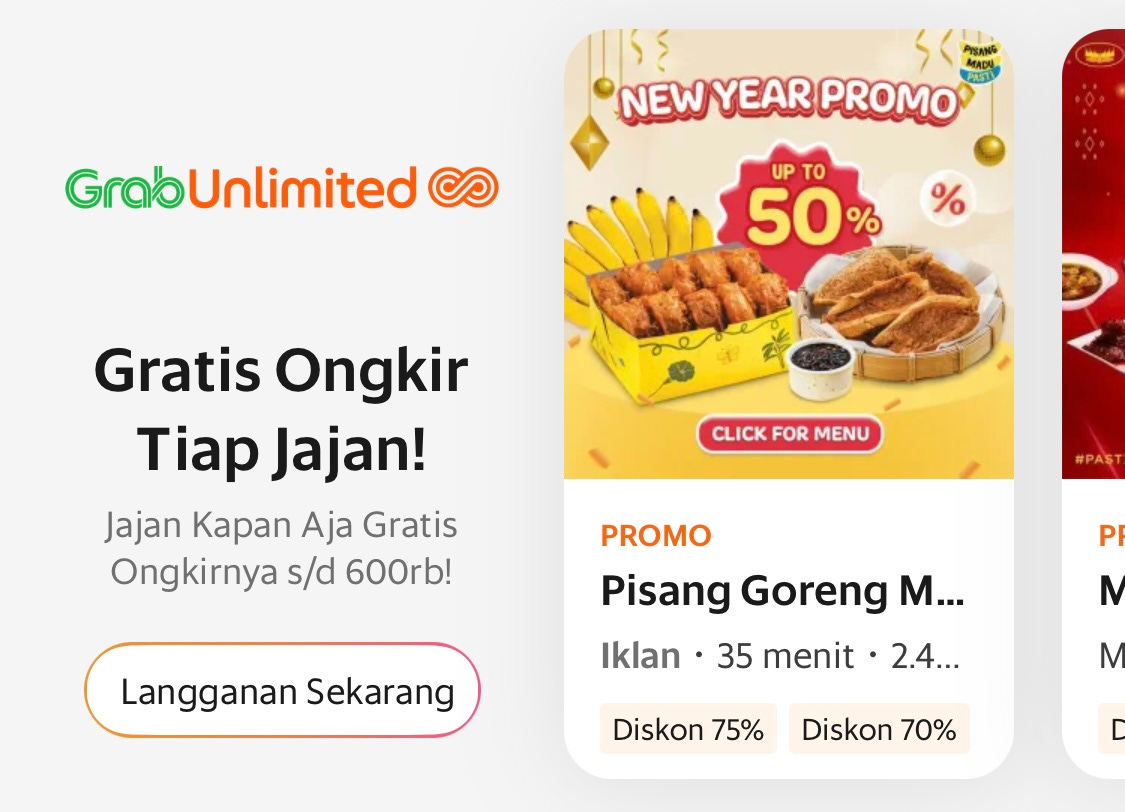Why Is Ordering Food Online So Hard?!
Food delivery apps are playing you (and you love it).

Halo and Happy Monday! Welcome to Kepayang — a personal newsletter and vibrant community for foodies, geeks, and creatives. Here, I (Fabi) talk about food, culture, and sustainability.
I've been wanting to write about today's topic for a while: food delivery apps. I used to be a big fan, but over time, they've become more frustrating than helpful. Not just because of the unnecessary service fees, though those are annoying too, but mainly because I often feel overwhelmed and struggle to decide what to eat. As someone who used to work in Tech, I think I can shed some light on what goes on behind the scenes and how we, as consumers, can be more mindful of our choices. So let’s jump in!
Don’t you think it’s funny that sometimes, when we have too many options, instead of making it easier for us to choose, it makes it even harder? It’s natural to be open to other choices. But when options pop up at a rate faster than our ability to decide, we may start to second-guess what we initially wanted and get overwhelmed.
That’s exactly how I feel when ordering food from a food delivery app.
Here’s what usually happens: Every other night after finishing my work, say, at 7 PM, I start thinking about what I want to eat. There are a few food places in my usual rotation, and I usually decide before I grab my phone and open the food delivery app.
Some apps I use interchangeably here in Indonesia are Gojek and Grab. Think of them like Uber — you can order a motorbike or a car to get to places, get your food delivered, or even send stuff.
The app itself is very straightforward. Or at least, at first. For example, when opening Gojek, it’s obvious that the red button with a spoon and fork icon and a ‘GoFood’ text is where you order food. But after clicking that, a million things appeared from foods you’ve ordered before, foods nearby, foods with the highest rating, and an endless scroll of brand-sponsored promotions.
Kepayang is free for now, so any engagements mean so much to support the platform’s growth. You can subscribe to get the newsletter sent directly to your email, like, comment, and share if you resonate with what I write.
Alternatively, you can buy me a coffee through my PayPal here: https://paypal.me/chalafabia - or if you’re based in Indonesia, you can send your donation through QRIS here (under the name Tamanan). Any amounts are welcomed and will directly contribute to sustaining this platform to cover expenses related to operations, research, writing, and marketing. ☕️
“I just need to find my nasi capcay (rice with ten types of sauteed veggies)”, I say to myself while hovering my finger over the keyboard, typing the name of the restaurant in the search box (let’s just call this place Restaurant X). But just before I finish typing, I start reconsidering buying from Restaurant Y, the one I saw in a promo a fraction of a second ago.
I love Restaurant Y. It’s one of my favourite places to eat. It’s a bit pricey, so it wasn’t on my mind initially, especially since it’s a random Tuesday night. “But they have a promotion, right?” I tell myself. So within seconds, I go back to check what it would cost to order from Restaurant Y. I add my usual dish, only to find out that it’s still over my budget for a midweek food delivery even after the discount. “Well, let me just go back and get my nasi capcay…” I think, trying to retrace my steps, but before I know it, I’m on Restaurant Z’s menu looking for a completely different dish for a completely different reason. Somehow, it’s 8 PM already, and I still haven’t clicked ‘order.’
Maybe it’s just me being easily distracted. Or maybe these apps are just really smart at showing me a million things I might like. But how?
To answer that, let’s get a bit technical and understand what the app wants us to do: order from them. This isn’t a bad thing — it’s business. They make money from it. And to make sure we keep ordering, these apps look into several things:
1. How recently we ordered food
Their goal is to stay relevant so we can’t get them out of our minds! You can see this in how they remember what you last ordered, and if you haven’t ordered in a while, they might lure you back with a push notification reminding you how much you loved them before maybe even throwing in a discount or free delivery voucher. Maybe this post is not about food delivery apps. But, anyway, sometimes, they make it even easier with an “Order Again” button, so with just one click, you can reorder the same dishes as before.
2. How often do we order food
These apps have our ordering habits down to a science. They know exactly how many times we order per month, week, or even per day, and if they see a chance to make us order more, they will.
One sneaky example (that most people don’t even realise) is the Flash Sale section. It’s cheap, it features crowd-favourite foods, and it’s strategically timed (e.g. es kopi susu (iced latte) and gorengan (fritters) promos hitting at 4 PM). Since it’s small and affordable, you eventually give in. Just a little treat, right?
Then there’s the subscription trap. Take GrabUnlimited, for example. For as little as Rp9,000 per fortnight, you get free delivery, discounts, and exclusive deals. If you’re a frequent Grab user, it might actually save you money. But if you’re not? The subscription fee might outweigh the savings, or worse, you might start ordering more just to “make the most” of it.
3. How much we spend on food
Aside from making us order more often, these apps also want us to spend more per order. And honestly, it’s a no-brainer for them. Restaurants pay at least 20% commission to the app, and since operational costs (like paying the driver) are roughly the same, bigger orders = bigger profits.
You’ve probably seen this in discounts for higher-priced meals, like promotions for orders over Rp100,000. Or those bundle deals, like two dozen J.Co doughnuts for your resignation party. Of course, you won’t always fall for it. These tactics only work when you actually need something. But when that moment comes, they’re ready to nudge you into spending more.
More choices aren’t always a good thing. So when does it create a paradox of choice?
Too Many Options: Some days, you have no idea what to eat. And when you’re in that state, it’s way too easy to fall into a scrolling rabbit hole that leads to indecision and frustration.
FOMO: Even when you do know what you want, having too many choices makes you second-guess yourself. What if I could save Rp10,000 by ordering from Restaurant X? What if Restaurant Y actually has better food?
This isn’t a hate fest against food delivery apps. Most days, they’re super helpful. But when you’re indecisive, they can be a double-edged sword. I just want you to be more mindful when ordering food. Be clear on what you want, preferably before opening the app, so it helps you rather than overwhelms you.
At this point, don’t hate the player, hate the game that is capitalism (OK, big word).
These tactics make sense because, at the end of the day, food delivery apps need money to keep running. They’re just playing by the rules of capitalism to maximise profit. But on the bright side, it’s not just the apps that benefit. Customers get more options and restaurants get better exposure. Sure, it can be annoying when recommendations don’t match our tastes, and the algorithm isn’t perfect. So for now, hate the game, not the player.
Other contents that I made recently:
🇹🇼 Read about what I ate in Taiwan, but I won’t tell you about the taste: here.
✈️ Read about why I think aeroplane food deserves more love: here.
🇹🇷 Read on how I learned about Turkiye’s inflation through food: here.
💥 Read about the smart Indonesian crunch culture: here.
🚦 Read on the problem behind street food vendors relocation: here.
🤔 Read on how Indonesians please others when it comes to food: here.
If you like today’s newsletter, please like and share it with your friends! Comment down below your thoughts and let me know if you have any other topics you want me to discuss. Until then, I’ll see you in two weeks!
Follow me everywhere:
TikTok: @berusahavegan
Kepayang’s Instagram: @readkepayang
Instagram: @menggemaskan
LinkedIn: Chalafabia Haris
Work with me: readkepayang@gmail.com






